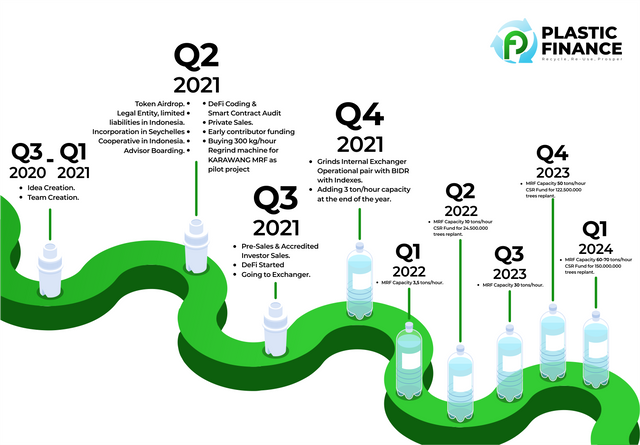Plastic Finance
Plastic Financing – Blockchain Startup in Plastic Waste Management

According to the United Nations, we throw away more than 2 billion tons of waste every year. Global waste could grow to 3.40 billion tonnes by 2050, more than double the population growth over the same period. The waste generated per person per day is an average of 0.74 kg, but varies widely: from 0.11 to 0.11 kg. 4.54 kilograms. By 2050, these figures could increase by 40% in low- and middle-income countries and 19% in high-income countries. The fastest growing regions are sub-Saharan Africa, South Asia and the Middle East and North Africa. Plastic accounts for about 12%, or 242 million tonnes, of total waste each year. About 91% of plastic waste is not recycled, and about 79% ends up in landfills or in the environment as waste.
Research shows that about 8 million tons of plastic are released into the oceans every year. There's some giant plastic soup in the ocean. The largest of them is located in the Pacific Ocean, with an area of 1.6 million square kilometers, or three times as much. French size. If the trend of increasing litter continues, there will be more plastic waste than fish in the oceans. Most plastics cannot be broken down by bacteria, but instead break down into smaller – smaller pieces. more than 5 millimeters, are known as microplastics. This fragmentation process is accelerated by ultraviolet light, which is abundant in the ocean and in open landfills. The fragments spread further across our planet, falling into our water and food sources.
Since 1950, we have produced more than 10 billion tons of plastic. Not surprisingly, more than 74,000 people can eat, drink and breathe. microplastic particles every year. Microplastics, or a much smaller version, nanoplastics, can penetrate our tissues. body. For example, inhaling nanoplastics can cause them to enter our cardiovascular system and bloodstream. The chemicals in plastics have been linked to a variety of health problems, including reproductive health problems. danger and obesity, organ problems and developmental delays in children. To handle plastic waste, an efficient recycling system is needed. Unfortunately, most recycling systems are not that efficient. Of the 270 million tons of plastic products per year, 242 million tons will become waste. Is it right, reducing usage is the preferred solution. However, given how dependent we are on the plastics industry, recycling remains a key solution.
How the Platform Works
Plastic Finance works in two ways: empowering the waste community (such as scavengers, scavengers, etc.) and rewarding those involved in the network. Scavengers will be rewarded for their contributions, where they have the option to earn money in tokens or fiat (real) money. If they prefer crypto tokens, they can actually take part in the platform. They can use this platform to gain access to finance, and this is rare because the trash community is usually the unbanked. Well, with this platform, these unbanked people can finally enjoy financial access
Project goals and mission
Plastic Finance focuses on recycling plastic by increasing the productivity of scavengers. We don't break the waste value chain; instead, we add value to the value chain for the benefit of all. In addition, we support a tree transplant program to decarbonize CO2 emissions, further strengthening our commitment to a circular economy.
The cooperative collects waste from its members (garbage collectors) and then sells it to the Material Recovery Facility (MRF). MRF sorts and recycles waste into various forms of waste that can be sold and then sells it to buyers of recycled waste. The relationship between Cooperative and MRF is symbiotic. Cooperatives need better terms of trade and MRFs need continuity of supply. The relationship between the Cooperative and the MRF is consolidated through the Cooperative's ownership of the MRF. The creation of an MRF requires a significant capital investment. This can be done by issuing a security token, PLAS, from Plastic Finance. In turn, MRF will share 60% of its annual profits with Plastic Finance, which distributes the net proceeds to PLAS holders as BUSD “dividends”.
Tokenomik
Score:
PLAS token type: BEP-20
MainNet token address: 0xCe34caAEe0b691F8e4098DC31CC8818A1dCcF06A
token sale Address: 0x1800C25a3Ed60B41766B8EE94f40CE05A84407aB
total token amount: 23,900,000 PLAS
profit
Token Sale
TOTAL SUPPLY: 23,900,000 PLAS TOTAL
PUBLIC SALES: 2,000,000 PLAS @ USD1
INITIAL EMPLOYEE: 7,300,000 PLAS banned for up to 27 months
ACCREDITED INVESTOR SALES: 2,000,000 PLAS @ $0.375, minimum $20,000
presale @ USD 2,000,000
PLAS 0 ,6 AIRDROP or community grant: 1,000,000 PLAS
pre-sale hardcap + accredited sale = $
1,950,000 General hardcap total sales = $2,000,000 (can be planned at IFO if pre-sale and private sale are successful)
Hardcap amount: $ 3.950.000
. PLAS price calculation related to USD value
Conclusion
Plastic Finance focuses on plastic recycling by increasing the productivity of scavengers. Plastic Financing does not disrupt the waste value chain; Instead, they add value to the value chain for the benefit of all parties. In addition, we support tree replanting programs to remove carbon from CO2 pollution and thereby support our commitment to a circular economy.
Schedule
Read more here:
️Website: https://plastic.finance
️Official Twitter: @Plastik _Finance
️Whitepaper: https://plastic.finance/whitepaper.pdf
️Official Telegram: https://t.me/plasticfinance
️Facebook: https://www.facebook.com/plastic.finance/
️Linkedin: https://www.linkedin.com/company/plastic-finance
Youtube: https://www.youtube.com/channel/UCxZvaGVdcOJ-_SnGaEn4kew
Username: Saulnigues
Link: https://bitcointalk.org/index.php?action=profile;u=3122432



Komentar
Posting Komentar